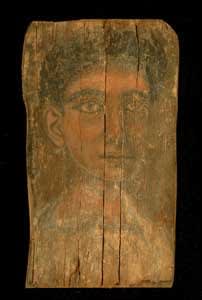Roman Period Egyptian Mummy Portrait Depicting a Young Man, 2nd Century CE
Paint on Wood
8.2 x 14.2
X.0380
Our evocative portrait depicts an aristocratic young man with curly hair, his head inclined toward our right hand side with the glance of his enormous eyes cast far into the...
Our evocative portrait depicts an aristocratic young man with curly hair, his head inclined toward our right hand side with the glance of his enormous eyes cast far into the distance. He appears to be wearing a white tunic without additional accessories. Recent scholarship suggests that such portraits may have been displayed in the homes of the elite members of Roman Egypt’s society in much that same way that we display portraits and photographs of our loved ones and friends today. Upon death, these portraits were reverentially entrusted to the funerary priests who ceremoniously attached them over the head of the deceased’s wrapped mummy.
There is a good parallel for our portrait in the collections of the British Museum [inventory number EA 6713] which is still attached to its intact mummy. That example is dated to the period between 200-250 AD, to which era our example should likewise be assigned.
Our portrait was painted on a very thin panel of wood, which, when taken into consideration with its age, understandably accounts for the splits which run vertically up the picture plane. The portrait is otherwise in stable condition.
References:
For these so-called Faiyum portraits in general, see, M-F Aubert and R. Cortopassi, Portraits de l’Egypte romaine (Paris 1998), and pages 90-91, catalogue number 45, for the parallel in London.
There is a good parallel for our portrait in the collections of the British Museum [inventory number EA 6713] which is still attached to its intact mummy. That example is dated to the period between 200-250 AD, to which era our example should likewise be assigned.
Our portrait was painted on a very thin panel of wood, which, when taken into consideration with its age, understandably accounts for the splits which run vertically up the picture plane. The portrait is otherwise in stable condition.
References:
For these so-called Faiyum portraits in general, see, M-F Aubert and R. Cortopassi, Portraits de l’Egypte romaine (Paris 1998), and pages 90-91, catalogue number 45, for the parallel in London.



